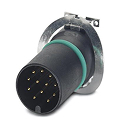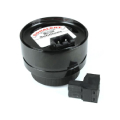Sensors and transducers convert physical inputs (pressure, temperature, magnetism, and sound) into electrical signals that systems can process. This category covers the basics: general sensors, magnetic sensors, pressure sensors, temperature sensors, audio components, and related accessories for integration and maintenance. These parts provide feedback, protection, and control in production lines and devices where accuracy and repeatability count. Online Components backs this work with reliable stock, U.S.-based shipping, and authorized sourcing.
Start with the variable and range you need to measure, then match it to the right device type: magnetic sensors for position or speed, pressure sensors for absolute or differential monitoring, temperature sensors for thermal control, and audio components for sound transduction.
Pin down output and interface next. Will you use analog voltage or current, or a digital bus such as Inter-Integrated Circuit (I²C), Serial Peripheral Interface (SPI), or Universal Asynchronous Receiver-Transmitter (UART) that fits your controller and bandwidth needs?
Confirm electrical and mechanical fit: supply voltage, package style, port geometry for pressure devices, and accessory requirements like cables or mounting hardware. Check environmental limits, too. Operating temperature, humidity tolerance, and Ingress Protection (IP) ratings all come into play when dust or moisture exposure is expected.
Procurement teams, test engineers, and design engineers pick these parts for new designs, line maintenance, and field retrofits. Magnetic sensors provide position feedback in factory automation while pressure sensors safeguard pneumatics and hydraulics.
Heating, ventilation, and air conditioning (HVAC) systems use temperature sensors for control loops and energy management. Building systems rely on general sensors for occupancy and status monitoring.
Medical and lab equipment depend on pressure and temperature sensors to stabilize pumps and maintain process conditions. Consumer and embedded products use audio components for signaling and detection tasks where acoustic cues count.
Online Components combines U.S.-based inventory, fast shipping, and authenticated supply to reduce risk and shorten lead times. The sensors and transducers selection is broad, with real-time availability and parametric filtering that speeds up part selection. Competitive screen pricing and responsive customer service make sourcing simpler.
Tie these specs to the decision or threshold in your system. Small changes that trigger control actions demand tighter accuracy and fine resolution. Where you only need coarse thresholds, a wider spec can reduce cost and complexity while maintaining reliability.
Analog outputs are simple and fast to read with an Analog-to-Digital Converter (ADC). Digital interfaces such as I²C, SPI, or UART add features like on-sensor filtering and diagnostics. Choose based on available microcontroller resources, noise tolerance, wiring length, and required sample rate.
Confirm operating temperature range, humidity exposure, and any needed IP protection. For pressure devices, verify media compatibility and port type. For audio components, review mounting and acoustic path constraints. Check calibration method, drift over time, and whether field calibration is supported to maintain long-term stability.
Yes. Proper cables, seals, and mounting accessories improve signal integrity, reduce mechanical stress, and preserve environmental ratings. Matching accessories to the sensor or transducer helps preserve accuracy and extend service life.
See More





